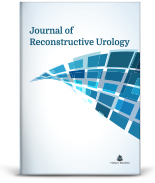Objective: The modified Makuuchi incision (MMI) consists of a midline incision from the xiphoid to just above the umbilicus, and a transverse incision to the 12th rib. It is J-shaped on the right and L-shaped on the left side. We aimed to evaluate the postoperative pain, incisional hernia, and cosmetic satisfaction of patients who underwent renal surgery with this technique. Material and Methods: Between January 1, 2015 and March 31, 2021, patients who performed simple, partial, and radical nephrectomy with MMI in our clinic were determined, and whose surgery was performed at least 3 months ago and had contact information in hospital records were called by phone. They were questioned in terms of incisional pain, incisional bulging or hernia, and cosmetic appearance. Results: A total of 152 patients with kidney surgery were identified. Ninety-seven were operated via MMI, and 57 of them were interviewed. Thirty-seven were male and 20 were female. The mean age was 55.3 years (21-86 years) and the mean postoperative follow-up period was 28 months (3-75 months). There was no patient with ongoing pain and was still in need of analgesics. Fortyfive patients (78.9%) stated that they were satisfied with the cosmetic appearance. One patient (1.7%) reported incisional bulging and 1 (1.7%) reported a hernia. Conclusion: In cases with large renal tumors or a history of previous abdominal surgery, MMI did not cause permanent and serious problems in terms of pain, cosmetic, and herniation. We think that it is useful to know this incision for urologists who are interted in complicated renal surgeries.
Keywords: Renal surgery; Makuuchi; pain; hernia; satisfaction
Amaç: Modifiye makuuchi insizyonu (MMI) ksifoid altından umblikusun hemen üzerine kadar linea alba üzerinde bir orta hat kesisi ve bu kesinin alt noktasından 12. kostaya uzanan transvers kesiden oluşur. Sağ taraf için J, sol taraf için L şeklindedir. Bu teknikle renal cerrahi yapılan hastaların postoperatif ağrı, insizyonel herni ve kozmetik açıdan memnuniyetlerini değerlendirmeyi amaçladık. Gereç ve Yöntemler: 1 Ocak 2015 ve 31 Mart 2021 tarihleri arasında kliniğimizde MMI ile basit, parsiyel ve radikal nefrektomi uygulanan hastalar hastane kayıtlarından belirlendi. İletişim bilgisine ulaşılabilen ve ameliyattan sonra en az 3 ay zaman geçen hastalar telefonla arandı ve yara yerindeki ağrı hakkında memnuniyetleri, yara yerinde şişlik ya da fıtık gelişip gelişmediği ve insizyona dair kozmetik açıdan memnuniyet durumları sorularak cevapları kaydedildi. Bulgular: Böbrek cerrahisi yapılan 152 hasta tespit edildi. Doksan yedi hastada MMI kullanılmıştı ve bunların 57'siyle telefonda görüşüldü. Hastaların 37si erkek, 20'si kadındı. Yaş ortalaması 55,3 yıl (21-86 yıl) ve postoperatif takip süresi ortalaması 28 aydı (3-75 ay). Takipte yara yerinde ağrısı devam ettiği için analjezik ihtiyacı olan hastaya rastlanmadı. Kırk beş hasta (%78,9) yara yeri iyileştikten sonraki kozmetik görünümden memnun olduğunu belirtti. Bir hasta insizyon yerinde şişlik (%1,7), 1 hasta (%1,7) herni bildirdi. Sonuç: MMI, büyük renal kitlelerde ve geçirilmiş batın operasyonu öyküsü olan vakalarda tercih edilebilmektedir. Çalışmamızda MMI'nın postoperatif dönemde analjezik kullanımı gerektirecek ağrıya yol açmadığını, kozmetik ve insizyon herniasyonu açılarından da ciddi sorun oluşturmadığını gördük. Bu nedenle komplike böbrek ameliyatları ile ilgilenen ürologlar için bu insizyonu bilmenin faydalı olduğunu düşünüyoruz.
Anahtar Kelimeler: Böbrek cerrahisi; Makuuchi; ağrı; herni; memnuniyet
- Polat F, Atan A, Yeşil S, Dikmen K, Ünsal A. Modified Makuuchi incision in the surgical treatment of renal tumors: Initial results. Turk J Urol. 2019;45(6):467-70. [Crossref] [PubMed] [PMC]
- Chang SB, Palavecino M, Wray CJ, Kishi Y, Pisters PW, Vauthey JN. Modified Makuuchi incision for foregut procedures. Arch Surg. 2010;145(3):281-4. [Crossref] [PubMed]
- Bokka SH, Sreenivasan Kodakkattil S, Manikandan R, Lalgudi Narayanan D, M H, Kalra S, et al. Usage of modified makuuchi incision for surgical management of complex renal and adrenal lesions. Cureus. 2020;12(10):e11012. [Crossref] [PubMed] [PMC]
- Ruffolo LI, Nessen MF, Probst CP, Jackson KM, Ruan DT, Schoeniger LO, et al. Open adrenalectomy through a makuuchi incision: A single institution's experience. Surgery. 2018;164(6):1372-6. [Crossref] [PubMed]
- Pandit N, Awale L, Adhikary S, Banerjee JK, Ghosh S, Kulkarni S, et al. Modified Makuuchi incision for major upper abdominal surgeries. Pol Przegl Chir. 2019;91(6):15-9. [Crossref] [PubMed]
- Inkiläinen A, Blomqvist L, Ljungberg B, Strigård K. Patient-reported outcome measures of abdominal wall morbidity after flank incision for open partial nephrectomy. BJU Int. 2021;128(4):497-503. [Crossref] [PubMed]
- Chatterjee S, Nam R, Fleshner N, Klotz L. Permanent flank bulge is a consequence of flank incision for radical nephrectomy in one half of patients. Urol Oncol. 2004;22(1):36-9. [Crossref] [PubMed]
- Hermann M, Gustafsson O, Sundqvist P, Sandblom G. Rate of incisional hernia after minimally invasive and open surgery for renal cell carcinoma: a nationwide population-based study. Scand J Urol. 2021;55(5):372-6. [Crossref] [PubMed]
- Zhou DJ, Carlson MA. Incidence, etiology, management, and outcomes of flank hernia: review of published data. Hernia. 2018;22(2):353-61. [Crossref] [PubMed]
- Togo S, Nagano Y, Masumoto C, Takakura H, Matsuo K, Takeda K, et al. Outcome of and risk factors for incisional hernia after partial hepatectomy. J Gastrointest Surg. 2008;12(6):1115-20. [Crossref] [PubMed]
- Suh SW, Lee KW, Lee JM, Choi Y, Yi NJ, Suh KS. Clinical outcomes of and patient satisfaction with different incision methods for donor hepatectomy in living donor liver transplantation. Liver Transpl. 2015;21(1):72-8. [Crossref] [PubMed]
- Darwish Murad S, Fidler JL, Poterucha JJ, Sanchez W, Jowsey SG, Nagorney D, et al. Longterm clinical and radiological follow-up of living liver donors. Liver Transpl. 2016;22(7):934-42. [Crossref] [PubMed]







.: Process List